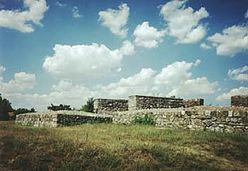Sucidava
| Castra Sucidava | |
|---|---|
 Ruins of Sucidava, modern Romania | |
| Known also as | Castra of Celeiu |
| Abandoned | 6th century |
| Attested by | Tabula Peutingeriana |
| Previous fortification | Dacian |
| Place in the Roman world | |
| Province | Dacia |
| Administrative unit | Dacia Malvensis |
| Nearby water | Danubius |
| Structure | |
| — Stone structure — | |
| Location | |
| Coordinates | 43°45′52″N 24°27′33″E / 43.7644°N 24.4591°E |
| Altitude | c. 37 m |
| Place name | Cartier Celei |
| Town | Corabia |
| County | Olt |
| Country | |
| Reference | |
| RO-LMI | OT-I-s-A-08492 |
| Site notes | |
| Recognition | |
| Condition | Ruined |
| Excavation dates | 1900 [1] |
| Archaeologists | Pamfil Polonic [1] |
Sucidava (Sykibid after Procopius,[2] Σucidava after Pârvan, where Σ is pronounced "sh"[3]) is a Dacian and Daco-Roman historical site, situated in Corabia, Romania, on the north bank of the Danube. The first Christian Basilica established in Romania can be found there and the foot of a Roman bridge over the Danube built by Constantine the Great to link Sucidava with Oescus (today in Bulgaria, in Moesia), in order to start the reconquest of Dacia. There is also a secret underground fountain which flows under the walls of the town to a water spring situated outside.
From an archaeological point of view, the coins found at Sucidava show an uninterrupted series from Aurelian (270-275) to Theodosius II (408-450).[citation needed] The archaeological evidence show that in AD 443 or 447 the city was sacked by the Huns, and was restored under Justin I 518-527 or Justinian I 527-565.[citation needed] Around 600, it seems that the Roman garrison abandoned the city.[2][dead link]
See also
References
- ^ a b "Manuscrisele lui Pamfil Polonic". cimec.ro. Archived from the original on 19 December 2011. Retrieved 15 December 2012.
- ^ a b Olga Karagiorgou "Archived copy" (PDF). Archived from the original (PDF) on 2011-08-10. Retrieved 2010-11-15.
{{cite web}}: CS1 maint: archived copy as title (link) - ^ Pârvan - ştiri din Dacia Malvensis http://www.cimec.ro/Arheologie/ParvanArticole/ParvanStiriNouaDinDaciaMalvensis.pdf)
Additional References
- Paul Lachlan MacKendrick, "The Dacian Stones Speak", Chapel Hill: University of North Carolina Press, 1975. ISBN 0-8078-1226-9
- Notitia Dignitatum cca 395-413
External links
- Sucidava on Tabula Peutingeriana: http://www.euratlas.net/cartogra/peutinger/7_thracia/thracia_4_1.html
- (in Romanian) "Archaeological Excavation Report"
- Photo gallery
- Gabriel Vasile, "Analiza antropologică a unui schelet descoperit la Sucidava - Celei (judeţul Olt)", Cercetări Arheologice, 13/2006, at National Museum of Romanian History
- http://www.threemonkeysonline.com/als/_sucidava_romania_eu_expansion.html
- Roman castra from Romania - Google Maps / Earth




